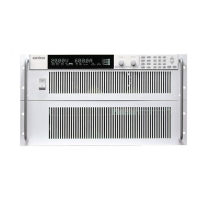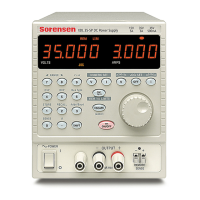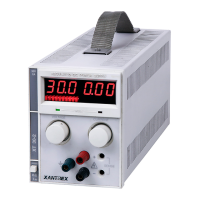Do you have a question about the Xantrex XDC 10-600 and is the answer not in the manual?
Covers defects in workmanship and materials for 5 years from purchase date.
Outlines Xantrex's options for repair or replacement and warranty continuation.
Provides instructions on contacting merchants or Xantrex for warranty service.
States the warranty is the sole and exclusive warranty provided by Xantrex.
Lists limitations and exclusions not covered by the limited warranty.
Details safety measures for operating the power supply, including high voltage warnings.
Lists standards met by CE-marked units, including IEC, EN, and EMC requirements.
States CSA certification compliance with specific standards.
Indicates UL listing status and compliance with laboratory equipment safety standards.
Confirms compliance with FCC Part 15 for radio frequency devices.
States compliance with Canadian EMC requirements.
Identifies the target audience for the manual based on their electrical knowledge.
Explains how to easily locate information within the manual using its structure.
Lists the main sections of the manual and provides brief descriptions.
General introduction to the XDC power supply series, its features, and applications.
Details the key digital and analog features of the XDC power supply.
Describes the physical layout and components of the power supply's front panel.
Explains the main display and status annunciators on the front panel.
Lists and explains the meaning of the various status annunciators on the front panel display.
Details the connectors and ports located on the rear panel of the power supply.
Explains the power supply's operation states and control modes.
Describes the power-on sequence and default settings.
Details the available control modes: Local, RS-232, GPIB, Multichannel, and Analog.
Provides an overview of the recommendations and procedures for installing the power supply.
Summarizes the steps for setting up the power supply, referencing detailed sections.
Lists the necessary equipment for performing basic checks and self-tests.
Describes how to perform a display test to ensure proper functionality.
Explains the importance of wire capacity for load wiring and provides a rating table.
Introduces the operation section, covering power on/off and configuration procedures.
Provides step-by-step instructions for powering on the power supply and initial checks.
Lists and describes the main menu options available on the power supply.
Details the procedure for setting the DC voltage output setpoint via the front panel.
Details the procedure for setting the DC current output setpoint via the front panel.
Describes how to switch between local (front panel) and remote control modes.
Guides the user through programming automated sequences with multiple steps.
Describes how to view the present power output in watts.
Refers to front panel indicators and annunciators for monitoring status.
Introduces the remote operation capabilities, including available interfaces and command formats.
Guides users on configuring the analog programming lines for voltage and current control.
Describes the physical connections for multichannel operation, including CANbus.
Lists SCPI commands for RS-232 configuration, including baud rate and flow control.
Describes how to use the RS-232 interface for remote control and mode switching.
Explains how to set the GPIB address and power-on service request settings.
Lists SCPI commands for GPIB control parameters and configuration.
Describes how to send GPIB commands and manage remote/local modes.
Covers SCPI commands for Factory Preset, Last Setting, User Settings, and Auto Sequence.
Includes SCPI for changing remote/local modes, enabling output, and programming V, I, P.
Details SCPI commands for setting voltage, current, power, temperature, and AC off protections.
Covers SCPI commands for programming, editing, and executing auto sequences and triggers.
Includes SCPI commands for reading and clearing error messages and querying status registers.
Introduces the current sharing function, its availability, and requirements for 6000 Watt units.
Explains how power supplies connected in parallel share current to deliver a larger output.
Describes how to operate the power supply when configured for current sharing, including master/slave roles.
Lists and explains potential errors encountered during current sharing operation.
Provides specifications related to current sharing, such as connected units and cable length.
Introduces the calibration procedures, noting software dependency and available methods.
Details how to enter calibration mode via front panel or SCPI commands, including security codes.
Explains how to restore the unit to its factory calibration constants.
Provides a summary of Standard Commands for Programmable Instruments (SCPI) supported by the power supply.
Lists the international standards to which the power supply conforms.
Describes the syntax rules, parameters, and hierarchy of SCPI commands.
Explains the structure of SCPI commands as organized around roots and nodes.
Provides a summary of supported SCPI commands with their function, description, and query capability.
Explains how errors are queued and cleared according to IEEE 488.2 standards.
Lists and describes errors related to IEEE 488.2 syntax errors detected by the instrument's parser.
Lists and describes errors detected by the instrument's execution control block after rounding and evaluation.
Introduces the GPIB interface for programming the power supply remotely.
General notes regarding the specifications provided in this appendix.
Defines the voltage and current ranges for the power supply output.
Provides typical and minimum efficiency ratings for the power supply.
Specifies load regulation for voltage and current under varying load conditions.
Specifies line regulation for voltage and current under varying input voltage.
Defines the programmable range for voltage, current, and power output.
Specifies the programmable range for Over-Voltage Protection.
Details operating and storage temperature ranges, and altitude limitations.
Specifies the operating and storage humidity ranges.
Lists the international certifications and standards met by the product.
Provides physical dimensions and weight specifications for the power supply units.
| Brand | Xantrex |
|---|---|
| Model | XDC 10-600 |
| Category | Power Supply |
| Language | English |












